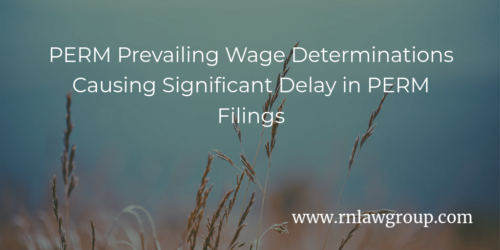
PERM Prevailing Wage Determinations Causing Significant Delay in PERM Filings
As part of the PERM Labor Certification (PERM) process, an employer must obtain a Prevailing Wage Determination (PWD) from the Department of Labor’s (DOL) National Prevailing Wage Center (NPWC). The prevailing wage is the rate the employer must at least offer the sponsored position at. It is also the rate that must be paid to the foreign worker once the green card is received. The NPWC issues PWDs based on multiple factors, including, but not limited to, the job title, job description, minimum requirements for the position, and the area of intended employment.
In addition to obtaining a PWD, employers must conduct recruitment to test the U.S. labor market for able, willing, qualified, and available U.S. workers for the sponsored job opportunity. This process helps ensure that U.S. workers will not be adversely impacted by hiring a foreign worker into a permanent position.
In a nutshell, the recruitment process involves advertising in multiple DOL mandated mediums and takes a minimum of 60 days to complete. Often, however, recruitment will exceed 60 days for multiple reasons. For example, employers may still be conducting interviews if resumes are received from U.S. workers or certain advertisements may not yet be complete. (For more information on the PERM recruitment process, visit PERM FAQs).
Currently, we are witnessing a significant increase in PWD processing times, with wage determinations taking a minimum of 6 months to be issued. This has caused significant delays in filing PERM applications. An employer cannot file a PERM application without a Prevailing Wage Determination. After a PWD request has been submitted, the employer generally has 2 options: (1) Begin the PERM recruitment process after the PWD is issued by the NPWC, or (2) begin the PERM recruitment process while the PWD request is still pending with the NPWC.
Recruitment After PWD Is Issued:
Most employers begin recruitment after the PWD is issued. Employers who choose this option must currently wait a minimum of 8 months before filing the PERM application – 6 months for the Prevailing Wage Determination plus 60 days minimum for recruitment. But remember, recruitment often exceeds the 60-day period. Although it is usually recommended to begin recruitment after the PWD is issued, there are certain urgent situations that may justify starting earlier.
A minimum of 8 months to file a PERM application can create major issues in urgent situations, especially considering it will take another 6-7 months to receive a PERM approval. One of the most common examples involves individuals in H-1B status who are approaching their 6-year limit. The maximum duration of stay in H-1B status is 6 years. In order to extend H-1B status beyond the 6-year limit, a foreign worker must have an employment-based green card in process.
Specifically, if you have a PERM application filed at least 365 days prior to the end of your 6-year limit, you may receive 1-year extensions of your H-1B status beyond the 6 year limitation. Further, if you have an approved I-140 Immigrant Petition, but your priority date is not current (an immigrant visa aka green card is not yet available to you) you may receive 3-year extensions of your H-1B status beyond the 6 year limitation. Therefore, timing of the PERM process is very important in this situation.
In order to speed up the process, employers may choose to begin recruitment while the PWD request is still pending.
Recruitment Before PWD Is Issued:
Currently, employers who begin recruitment while the PWD request is pending may be able to file a PERM application in 6 months as opposed to 8 months. This is of course assuming that recruitment is complete by the time the PWD is issued.
Although this option may offer a faster track to filing a PERM application, there are risks involved. For example, if the PWD is issued higher than expected and higher than what the employer is willing to offer, the company may have to resubmit a new PWD request and run a new set of advertisements. In doing so, the employer has wasted resources on advertising for the role.
Further, advertisements are only valid for 180 days and, as mentioned, PWDs are taking 6 months to be issued. Starting recruitment too early may result in advertisements expiring before the PWD is issued. Therefore, it is recommended that employers wait at least 3 months after the submission of the PWD to begin recruitment. This offers some leeway if PWD processing times increase beyond 6 months.
Conclusion
In the last two years PERM processing times have steadily increased. Not only have processing times increased for Prevailing Wage Determinations, but they have increased for PERM adjudications as well (the DOL is taking about 6-7 months to process filed PERM applications). Employers are often surprised to learn how long this process can take. It is essential that employers starting the process understand how important timing is, especially for employees approaching the end of their temporary work authorization (e.g. H-1B max, L-1 max, OPT/STEM OPT).
If you are starting the PERM process, please contact a qualified immigration attorney so that a proper plan of action can be made for your unique situation.
By: Krystal Alanis
Krystal Alanis is a Partner at Reddy Neumann Brown PC She acts as the Managing Attorney for the firm’s PERM Labor Certification Department, where she oversees all EB-2 and EB-3 employment-based green card matters. She also guides employers and individuals through the I-140 and Adjustment of Status process, assists clients with non-immigrant visa petitions (e.g. H-1B, TN, L-1, etc.), and advises her clients on I-9 compliance issues.

